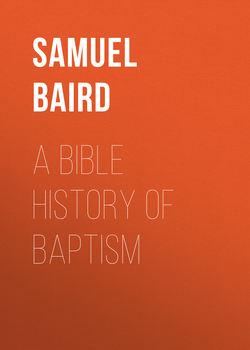Читать книгу A Bible History of Baptism - Baird Samuel John - Страница 17
Book I.
OLD TESTAMENT HISTORY
Part III.
ADMINISTERED BAPTISMS=SPRINKLINGS
Section XIV. —The Baptism of a healed Leper
ОглавлениеThe rites appointed for the purifying of a healed leper come under two heads, – those administered by the priest, and those performed by the person himself. When a leper was healed, he was first inspected by the priest, who went forth to him to ascertain that the healing was real, and the disease eradicated. This being ascertained, the priest took two clean birds, and had one of them killed and its blood caught in an earthen vessel, with running water. He then took the remaining bird, alive, with cedar wood, scarlet, and hyssop, and dipped all together in the blood and water; “and he shall sprinkle upon him that is to be cleansed from the leprosy seven times, and shall pronounce him clean, and shall let the living bird loose into the open field.” – Lev. xiv, 7.
The rite which thus ended by the official decree of the priest, “He is clean,” completed the purification, properly so called. The man is now clean. The remaining ordinances were expressive of duties and privileges proper to one who is cleansed and restored to the commonwealth of Israel, and the communion of God’s house. First of these he was required to “wash his clothes, and shave off all his hair, and wash himself in water, that he may be clean.” – Ib., vs. 8. He was now admitted to the camp, but must not yet enter his own tent, nor come to the tabernacle for seven days. On the seventh day he was again required to shave off all his hair, wash his clothes, and bathe his flesh; and “he shall be clean.” – Vs. 9.
Now, on the eighth day, he came to the sanctuary, bringing a sacrifice of a trespass offering, a sin offering, and a burnt offering. The rites attendant upon these offerings completed the ceremonial. Thenceforth, the leper resumed all the privileges of a son of Israel, in his family, in the the congregation, and at the sanctuary.
The general signification of these ordinances is evident. The priest, by whom alone the cleansing rites could be administered, was the official representative of our great high-priest, Christ Jesus. The two birds were with the priest a complex type of him who offered himself without spot to God, who was dead and is alive for evermore, and by the merits of whose blood and the power of whose Spirit remission of sins and the new life of holiness are given to men. The first self-washing symbolized the duty of the redeemed to turn from their old ways and walk in holiness. The continued exclusion, for seven days, from his house and the sanctuary was a testimony that for the present we are pilgrims and strangers, and that only at the end of earth’s trials and purgations can we enter our “house which is from heaven.” The seventh day’s washing indicated the final putting off of all evil in the resurrection; and the offerings of the eighth represented the way whereby, in the regeneration, God’s redeemed people shall have access to his presence and communion with him, through the blood of Jesus.
We are now able to understand why the cleansing of the healed leper was thus separately ordered, and not included in the provision which we shall presently see was made, in common, for all other cases of seven days’ uncleanness. The extraordinary and frequently supernatural character of both the disorder and its cure rendered it proper and necessary to take it out of the category of ordinary uncleannesses, and place it under the immediate jurisdiction of the priests. This was necessary, alike, in order to a judicial determination at first as to the existence of the leprosy, and afterward as to the cure. And the priestly administration of the rites of cleansing was equally important, as constituting an official and authoritative proclamation of the healing and restoration of the leper.
